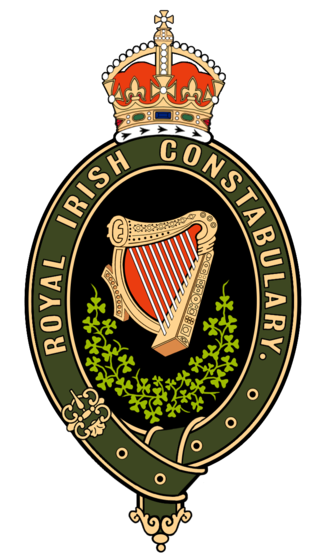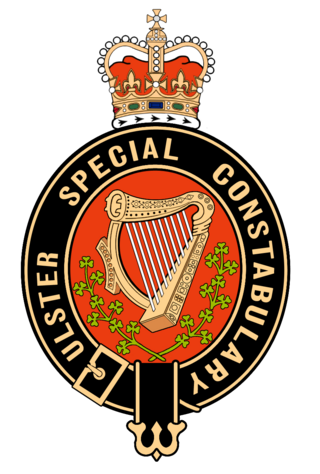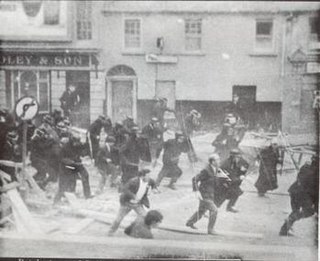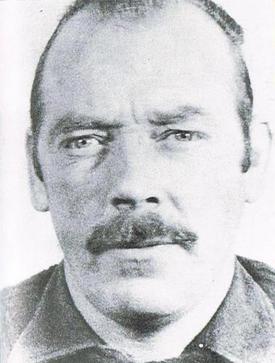Related Research Articles

The Troubles were an ethno-nationalist conflict in Northern Ireland that lasted for about 30 years from the late 1960s to 1998. Also known internationally as the Northern Ireland conflict, it is sometimes described as an "irregular war" or "low-level war". The conflict began in the late 1960s and is usually deemed to have ended with the Good Friday Agreement of 1998. Although the Troubles mostly took place in Northern Ireland, at times violence spilled over into parts of the Republic of Ireland, England, and mainland Europe.

The Royal Ulster Constabulary (RUC) was the police force in Northern Ireland from 1922 to 2001. It was founded on 1 June 1922 as a successor to the Royal Irish Constabulary (RIC) following the partition of Ireland. At its peak the force had around 8,500 officers, with a further 4,500 who were members of the RUC Reserve.

The Royal Irish Constabulary was the police force in Ireland from 1822 until 1922, when all of the country was part of the United Kingdom. A separate civic police force, the unarmed Dublin Metropolitan Police (DMP), patrolled the capital and parts of County Wicklow, while the cities of Derry and Belfast, originally with their own police forces, later had special divisions within the RIC. For most of its history, the ethnic and religious makeup of the RIC broadly matched that of the Irish population, although Anglo-Irish Protestants were overrepresented among its senior officers.

The Ulster Special Constabulary was a quasi-military reserve special constable police force in what would later become Northern Ireland. It was set up in October 1920, shortly before the partition of Ireland. The USC was an armed corps, organised partially on military lines and called out in times of emergency, such as war or insurgency. It performed this role most notably in the early 1920s during the Irish War of Independence and the 1956-1962 IRA Border Campaign.
The Ulster Defence Regiment (UDR) was an infantry regiment of the British Army established in 1970, with a comparatively short existence ending in 1992. Raised through public appeal, newspaper and television advertisements, their official role was the "defence of life or property in Northern Ireland against armed attack or sabotage" but unlike troops from Great Britain they were never used for "crowd control or riot duties in cities". At the time the UDR was the largest infantry regiment in the British Army, formed with seven battalions plus another four added within two years.

The Battle of the Bogside was a large three-day riot that took place from 12 to 14 August 1969 in Derry, Northern Ireland. Thousands of Catholic/Irish nationalist residents of the Bogside district, organised under the Derry Citizens' Defence Association, clashed with the Royal Ulster Constabulary (RUC) and loyalists. It sparked widespread violence elsewhere in Northern Ireland, led to the deployment of British troops, and is often seen as the beginning of the thirty-year conflict known as the Troubles.
Ulsterisation refers to one part – "primacy of the police" – of a three-part strategy of the British government during the conflict known as the Troubles. The strategy was to disengage the non-Ulster regiments of the British Army as much as possible from duties in Northern Ireland and replace them with members of the locally recruited Royal Ulster Constabulary (RUC) and Ulster Defence Regiment (UDR). The objective of this policy was to confine the effects of the conflict to Northern Ireland.
The following outline is provided as an overview of and topical guide to the Troubles.

Operation Banner was the operational name for the British Armed Forces' operation in Northern Ireland from 1969 to 2007, as part of the Troubles. It was the longest continuous deployment in British military history. The British Army was initially deployed, at the request of the unionist government of Northern Ireland, in response to the August 1969 riots. Its role was to support the Royal Ulster Constabulary (RUC) and to assert the authority of the British government in Northern Ireland. This involved counter-insurgency and supporting the police in carrying out internal security duties such as guarding key points, mounting checkpoints and patrols, carrying out raids and searches, riot control and bomb disposal. More than 300,000 soldiers served in Operation Banner. At the peak of the operation in the 1970s, about 21,000 British troops were deployed, most of them from Great Britain. As part of the operation, a new locally-recruited regiment was also formed: the Ulster Defence Regiment (UDR).

During 12–16 August 1969, there was an outbreak of political and sectarian violence throughout Northern Ireland, which is often seen as the beginning of the thirty-year conflict known as the Troubles. There had been sporadic violence throughout the year arising out of the Northern Ireland civil rights campaign, which demanded an end to discrimination against Catholics and Irish nationalists. Civil rights marches had been attacked by Protestant loyalists, and protesters often clashed with the Royal Ulster Constabulary (RUC), the overwhelmingly Protestant police force.

William McCaughey was a member of the Royal Ulster Constabulary's Special Patrol Group and the illegal Ulster Volunteer Force's Glennane gang in the 1970s. He was imprisoned for 16 years for murder from 1980 to 1996. On his release he worked as a loyalist and Orange Order activist until his death in 2006.
Derek Robert Hussey is an Ulster Unionist Party (UUP) politician, serving as a Derry and Strabane Councillor for the Derg DEA since 2014. Hussey was a Member of the Northern Ireland Assembly (MLA) for West Tyrone from 1998 to 2007.
The Reavey and O'Dowd killings were two coordinated gun attacks on 4 January 1976 in County Armagh, Northern Ireland. Six Catholic civilians died after members of the Ulster Volunteer Force (UVF), an Ulster loyalist paramilitary group, broke into their homes and shot them. Three members of the Reavey family were shot at their home in Whitecross and four members of the O'Dowd family were shot at their home in Ballydougan. Two of the Reaveys and three of the O'Dowds were killed outright, with the third Reavey victim dying of brain haemorrhage almost a month later.

John William Nixon, MBE, was a unionist politician and police leader in Northern Ireland who was alleged to be responsible for several sectarian atrocities, including the McMahon killings and the Arnon Street killings. It was widely believed that Nixons "murder gang" within the Royal Irish Constabulary (RIC) hunted down and murdered Catholics as reprisals for the killing of police.

The Police Act 2000 is an Act of the Parliament of the United Kingdom. The act renamed the Royal Ulster Constabulary (RUC) to the Police Service of Northern Ireland (PSNI). It also created the Northern Ireland Policing Board and District Police Partnerships. The act was designed to gain cross-community support for law enforcement in Northern Ireland with several initiatives included in the act, including a change of oath of office and a 50:50 recruitment policy for Protestants and Roman Catholics.

William Henry Wilson Hanna MM was a high-ranking Ulster loyalist who founded and led the Mid-Ulster Brigade of the Ulster Volunteer Force (UVF) until he was killed, allegedly by Robin Jackson, who took over command of the brigade.
John Oliver Weir is an Ulster loyalist born and raised in the Republic of Ireland. He served as an officer in Northern Ireland's Royal Ulster Constabulary's (RUC) Special Patrol Group (SPG), and was a volunteer in the illegal Ulster Volunteer Force (UVF). As a member of the UVF's Mid-Ulster Brigade led by Robin "the Jackal" Jackson, Weir was a part of the Glenanne gang, a group of loyalist extremists that carried out sectarian attacks mainly in the County Armagh area in the mid-1970s.

The Coagh ambush was a military confrontation that took place in County Tyrone, Northern Ireland, on 3 June 1991, during The Troubles, when a Provisional Irish Republican Army (IRA) active service unit from its East Tyrone Brigade was ambushed by the British Army's Special Air Service (SAS) at the village of Coagh, in County Tyrone, whilst on its way to kill a part-time member of the Ulster Defence Regiment (UDR). The ambush resulted in the deaths of all three IRA men involved.
On 11 August 1970, two Royal Ulster Constabulary (RUC) officers were killed by a booby-trap bomb planted under a car by the Provisional Irish Republican Army (IRA) near Crossmaglen, in County Armagh, Northern Ireland. They were the first RUC officers to be killed by republicans during the Troubles and the first security forces to be killed in South Armagh, an IRA stronghold for much of the conflict.

The 1990 Lough Neagh ambush was a gun attack carried out by the Provisional IRA on 10 November 1990 at Castor Bay, near Morrows Point, Lough Neagh, County Armagh, Northern Ireland targeting members of the security forces involved in a waterfowl hunting trip with other two men at the time. An active service unit of the IRA's North Armagh Brigade shot dead a Royal Ulster Constabulary (RUC) Inspector, an RUC Reservist, a former Ulster Defence Regiment (UDR) soldier and one civilian. Some members of the wildfowling party struggled with their attackers, and one of the constables returned fire before being killed.
References
- ↑ Mansbach, Richard (1973), Northern Ireland: Half a Century of Partition, Facts on File, Inc, New York, pgs 64-66, ISBN 0-87196-182-2
- ↑ Archer, Bimpe (11 October 2019). "Victor Arbuckle, first police officer killed in the Troubles, remembered 50 years on". The Irish News. Retrieved 10 August 2022.
- ↑ "The Hunt Report is published. | Royal Irish - Virtual Military Gallery". www.royal-irish.com. Retrieved 10 August 2022.
- ↑ "Aftermath of the Hunt report | Magill". magill.ie. Retrieved 10 August 2022.
- ↑ McKittrick, David. Lost Lives: The Stories of the Men, Women and Children who Died as a Result of the Northern Ireland Troubles, Random House, 2001. p. 42
- ↑ "UDR came to be seen as carbon copy of Protestant-only B-Specials | The Pat Finucane Centre". www.patfinucanecentre.org. Retrieved 10 August 2022.
- ↑ Goldsmith, Andrew; Lewis, Colleen (2000). Civilian Oversight of Policing: Governance, Democracy and Human Rights. Bloomsbury. p. 267. ISBN 978-1841130309.
- ↑ Baron Hunt (October 1969). "Report of The Advisory Committee on Police in Northern Ireland". Belfast: Her Majesty's Stationery Office . Retrieved 25 February 2015– via cain.ulst.ac.uk. (Extract-chapters 1.General Considerations about our Mission) & 10.Conclusions and Recommendations, only)